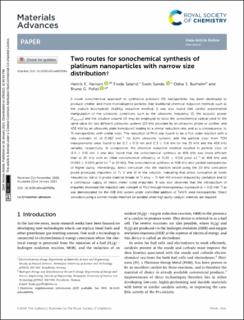| dc.contributor.author | Hansen, Henrik Erring | |
| dc.contributor.author | Seland, Frode | |
| dc.contributor.author | Sunde, Svein | |
| dc.contributor.author | Burheim, Odne Stokke | |
| dc.contributor.author | Pollet, Bruno | |
| dc.date.accessioned | 2022-03-04T09:40:54Z | |
| dc.date.available | 2022-03-04T09:40:54Z | |
| dc.date.created | 2021-08-24T17:13:34Z | |
| dc.date.issued | 2021 | |
| dc.identifier.citation | Materials Advances. 2021, 2 (6), 1962-1971. | en_US |
| dc.identifier.issn | 2633-5409 | |
| dc.identifier.uri | https://hdl.handle.net/11250/2983044 | |
| dc.description.abstract | A novel sonochemical approach to synthesize platinum (Pt) nanoparticles has been developed to produce smaller, and more monodisperse particles than traditional chemical reduction methods such as the sodium borohydride (NaBH4) reduction method. It was also found that careful experimental manipulation of the ultrasonic conditions such as the ultrasonic frequency (f), the acoustic power (Pacoustic) and the solution volume (V) may be employed to tailor the sonochemical radical yield to the same value for two different ultrasonic systems (20 kHz provided by an ultrasonic probe or sonifier, and 408 kHz by an ultrasonic plate transducer) leading to a similar reduction rate, and as a consequence, to Pt-nanoparticles with similar sizes. The reduction of Pt(IV) was found to be a first order reaction with a rate constant (k) of 0.062 min−1 for both ultrasonic systems, and the particle sizes from TEM measurements were found to be (2.2 ± 0.5) nm and (2.3 ± 0.4) nm for the 20 kHz and the 408 kHz samples, respectively. In comparison, the chemical reduction method resulted in particle sizes of (3.0 ± 0.5) nm. It was also found that the sonochemical synthesis at 408 kHz was more efficient than at 20 kHz with an initial sonochemical efficiency of (0.20 ± 0.04) μmol kJ−1 at 408 kHz and (0.060 ± 0.004) μmol kJ−1 at 20 kHz. The sonochemical synthesis at 408 kHz also yielded nanoparticles of higher purity. Interestingly, direct sonication into the reaction vessel using the 20 kHz sonication probe produced impurities of Ti, V and Al in the solution, indicating that direct sonication at lower frequencies led to (i) probe material (made of Ti alloy – Ti-6Al-4V) erosion induced by cavitation and (ii) a continuous supply of micro meter sized impurities. It was also observed that the introduction of impurities increased the reduction rate constant of Pt(IV) through heterogeneous nucleation (k = 0.12 min−1) as was demonstrated for the 408 kHz system under controlled addition of Ti/Al/V seed microparticles. Direct sonication using a sonifier should therefore be avoided when high purity catalytic materials are required. | en_US |
| dc.language.iso | eng | en_US |
| dc.publisher | Royal Society of Chemistry | en_US |
| dc.rights | Navngivelse-Ikkekommersiell 4.0 Internasjonal | * |
| dc.rights.uri | http://creativecommons.org/licenses/by-nc/4.0/deed.no | * |
| dc.title | Two routes for sonochemical synthesis of platinum nanoparticles with narrow size distribution | en_US |
| dc.type | Journal article | en_US |
| dc.type | Peer reviewed | en_US |
| dc.description.version | publishedVersion | en_US |
| dc.source.pagenumber | 1962-1971 | en_US |
| dc.source.volume | 2 | en_US |
| dc.source.journal | Materials Advances | en_US |
| dc.source.issue | 6 | en_US |
| dc.identifier.doi | 10.1039/d0ma00909a | |
| dc.identifier.cristin | 1928451 | |
| cristin.ispublished | true | |
| cristin.fulltext | original | |
| cristin.qualitycode | 1 | |

